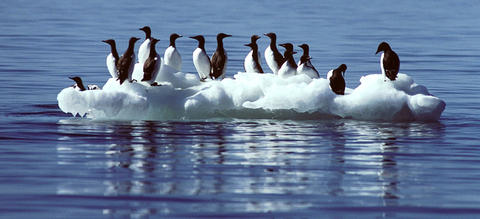
Common murres sitting on floating ice near Cape Lisburne, Alaska. Eggs from this species are being used to monitor the cycling of mercury in the Arctic biosphere.
An international research team working with National Institute of Standards and Technology (NIST) scientists at the Hollings Marine Laboratory (HML) in Charleston, S.C., has suggested for the first time that mercury cycling in the flora and fauna of the Arctic may be linked to the amount of ice cover present. Their study is the latest work reported from the Seabird Tissue Archival and Monitoring Project (STAMP), a multiyear joint effort of NIST, the U.S. Fish and Wildlife Service (USFWS), the U.S. Geological Survey (USGS) and the Bureau of Indian Affairs to track trends in pollutants in northern marine environments using seabird eggs.
Overall mercury levels in northern environments have been documented for some 20 years. However, the new study marks the first time that the tracking has been done using a sophisticated analysis of mercury isotopes (forms of the same atom that have different atomic masses) and an effect called "mass-independent fractionation" or MIF.
MIF is a relatively unusual change in the relative abundance of different isotopes of the same element (fractionation) that can be the result of photochemical reactions. Determining the relative amount of the MIF isotopes of mercury is considered valuable because the data can be used to trace the reactions in nature that led to the fractionation—and in turn, provide a better understanding of how the reactions work and how they impact the cycling of mercury in the environment.
Ultraviolet radiation from sunlight can fractionate mercury on the ocean surface via a process known as photodegradation. Laboratory research has shown that this reaction preferentially selects for some isotopes of mercury to move into the atmosphere while others become more abundant in the ocean. Plankton absorb the water-borne mercury, fish eat the plankton, and finally, sea birds eat the fish and pass the ingested mercury into their eggs. Therefore, the eggs are key tissues for mercury monitoring. For the current study, field groups made up of biologists and native Alaskans (for whom seabird eggs are a food source) collected eggs laid by murres, a bird species that nests year-round in three coastal regions of Alaska.
Examination of murre eggs from the northernmost nesting areas where sea ice exists all year long revealed lower amounts of MIF mercury isotopes than in eggs collected from sites in southern Alaska where there is no ice cover. Conversely, the mercury in eggs from nests near ice-free seas reflected significantly greater effects of mass-independent fractionation. The researchers believe that ice prevents UV light from reaching the mercury, effectively suppressing photodegradation.
With the potential for global warming to dramatically reduce Arctic sea ice in the future, the relationship between ice cover and distribution of mercury in the environment is obviously an important one to investigate further. The international research team next plans to use its seabird egg isotope monitoring system to distinguish the sources of mercury contamination in coastal areas to those from oceanic waters. For this study, eggs will be collected along Alaska's Norton Sound that receives runoff from the Yukon River—including high concentrations of cinnabar, the ore from which mercury is derived—and compared to eggs from remote island colonies that are more influenced by atmospheric and oceanic mercury sources.
Teaming on this study with NIST scientists at the HML were staff from the USFWS Alaska Maritime National Wildlife Refuge (Homer, Alaska), Environment Canada (Saskatoon, Saskatchewan, Canada), the Labotatoire des Mécanismes et Transferts en Géologie (Toulouse, France) and the Institut Pluridisciplinaire de Recherche sur ľEnvironnement et les Matreriaux (Pau, France). Financial support for the research was provided by NIST, the French Centre National de la Recherche Scientifique and a grant from the French Agence Nationale de Recherche.
The HML is a unique partnership of governmental and academic agencies including NIST, NOAA's National Ocean Service, the South Carolina Department of Natural Resources, the College of Charleston and the Medical University of South Carolina.
D. Point, J.E. Sonke, R.D. Day, D.G. Roseneau, K.A. Hobson, S.S. Vander Pol, A.J. Moors, R.S. Pugh, O.F.X. Donard and P.R. Becker. Methylmercury photodegradation influenced by sea ice over in Arctic marine ecosystems. Nature Geoscience. Published online Jan. 16, 2011.

